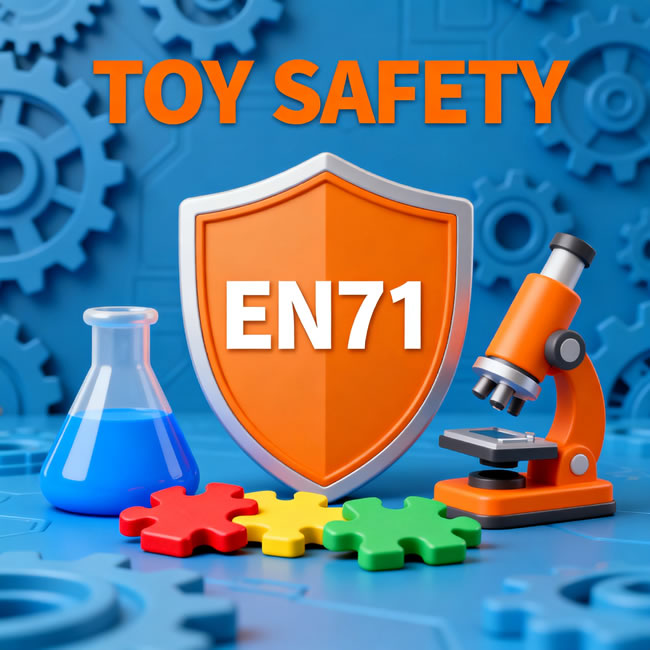
EU EN71 Toy Safety Testing Certification
Author: admin
Date: 2023-09-07 16:53:42
Visits: 167
With the official entry into force of three new EU EN 71-15/16/17 test standards on August 31, 2025, export compliance requirements for foam toys, rubber products and other categories have undergone significant upgrades. As a mandatory safety standard for toy products in the EU market, EN71 certification has become a "passport" for global toy enterprises to enter the European market. This page will comprehensively analyze the core content, latest developments and enterprise compliance key points of EN71 certification.
1. Introduction to EN71 Certification
EN71 is a series of toy safety standards developed by the European Committee for Standardization (CEN). It aims to ensure the safety of toys used by children under 14 years old through strict physical, chemical and mechanical performance tests. In accordance with the EU Toy Safety Directive 2009/48/EC, all toys entering the EU market must comply with relevant EN71 standards and pass compliance assessment.
Scope of Application: Covers seven categories including plastic toys, plush toys, electronic toys (power supply voltage ≤24V), wooden toys, chemical experiment toys, sports toys and baby toys. Non-toy children's products (such as stationery) or adult products are not within the scope of certification.
2. Certification Marking and Compliance Requirements
Products that have passed EN71 certification must be affixed with the CE marking, which is a mandatory mark for entering the EU market. The use of the mark must comply with the following specifications:
Mark Specification: Height not less than 5mm, clearly identifiable and permanently attached
Additional Information: Must be marked with the manufacturer's name/address, product model and age warning (such as "3+" symbol) at the same time
Technical Documents: Design drawings, test reports, risk assessments and other documents must be prepared and kept for at least 10 years for regulatory review
Common Misunderstanding: Simply affixing the CE mark without completing EN71 testing is an illegal act, which may lead to product recall and heavy fines.
3. Core Significance for Enterprises
Market Access Guarantee
As a statutory requirement of the EU, EN71 certification is a necessary condition for products to enter 27 EU countries and EEA regions, covering a consumer market of more than 500 million people.
Risk Avoidance Mechanism
In 2023, the EN71-12 standard tightened the N-nitrosamine limit for rubber toys from 0.05mg/kg to 0.01mg/kg. Compliance can avoid recall risks caused by exceeding the limit.
Brand Competitiveness Enhancement
Certification marks can enhance the trust of EU consumers. Statistics show that products passing EN71 certification can have a premium space of 15%-20%.
4. Certification Process and Cycle
Standard Confirmation Stage: Determine the applicable standards according to the product type (e.g., electronic toys need additional testing for EN 62115)
Laboratory Selection: Entrust third-party laboratories recognized by the EU such as TÜV and SGS to conduct testing
Sample Testing: Physical testing (sharp point/edge inspection, pull test) + chemical testing (heavy metal migration, phthalate content)
Factory Audit: The certification body conducts on-site audits of production facilities to verify the effectiveness of the quality control system
Certificate Issuance: Obtain a compliance certificate after passing the test and audit. There is no fixed validity period, but annual supervision and re-inspection are required
Cycle Cost: Usually takes 3-6 months, and the cost ranges from thousands to tens of thousands of euros depending on the complexity of the product.
5. Core Standards and 2025 New Regulations
Standard Number | Core Content | Effective Date |
|---|---|---|
EN 71-1 | Physical and mechanical properties (small parts suffocation risk, sharp edges, etc.) | Currently effective |
EN 71-3 | Restrictions on 19 migratable heavy metal elements | Currently effective |
EN 71-12 | N-nitrosamine content limit (rubber toys) | Updated in 2023 |
EN 71-15:2025 | Formamide test method for foam toys | 2025.08.31 |
EN 71-16:2025 | Chlorinated phosphorus flame retardant detection | 2025.08.31 |
EN 71-17:2025 | Isothiazolinone test for water-based materials | 2025.08.31 |
6. Key Notes
Material Control: Avoid using recycled plastics and prioritize environmentally friendly coatings certified by EN71-3
Design Specification: 3D printed toys need additional fracture testing to prevent the risk of small parts falling off
Continuous Compliance: Annual supervision audits need to prepare production records, raw material purchase vouchers and other documents
Standard Tracking: Pay attention to the revision announcements issued by CEN, such as the special requirements for foam toys in the new standards added in 2025
Special Reminder: After August 31, 2025, all foam toys exported to the EU must be tested in accordance with the new EN 71-15/16/17 standards. Products that do not meet the standards will be detained by EU customs.
Send Inquiry
